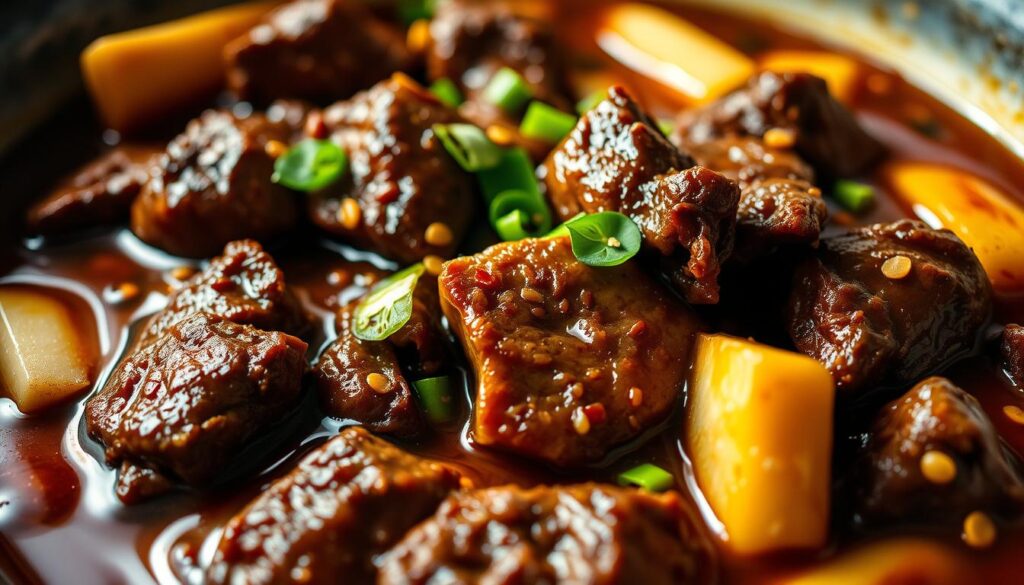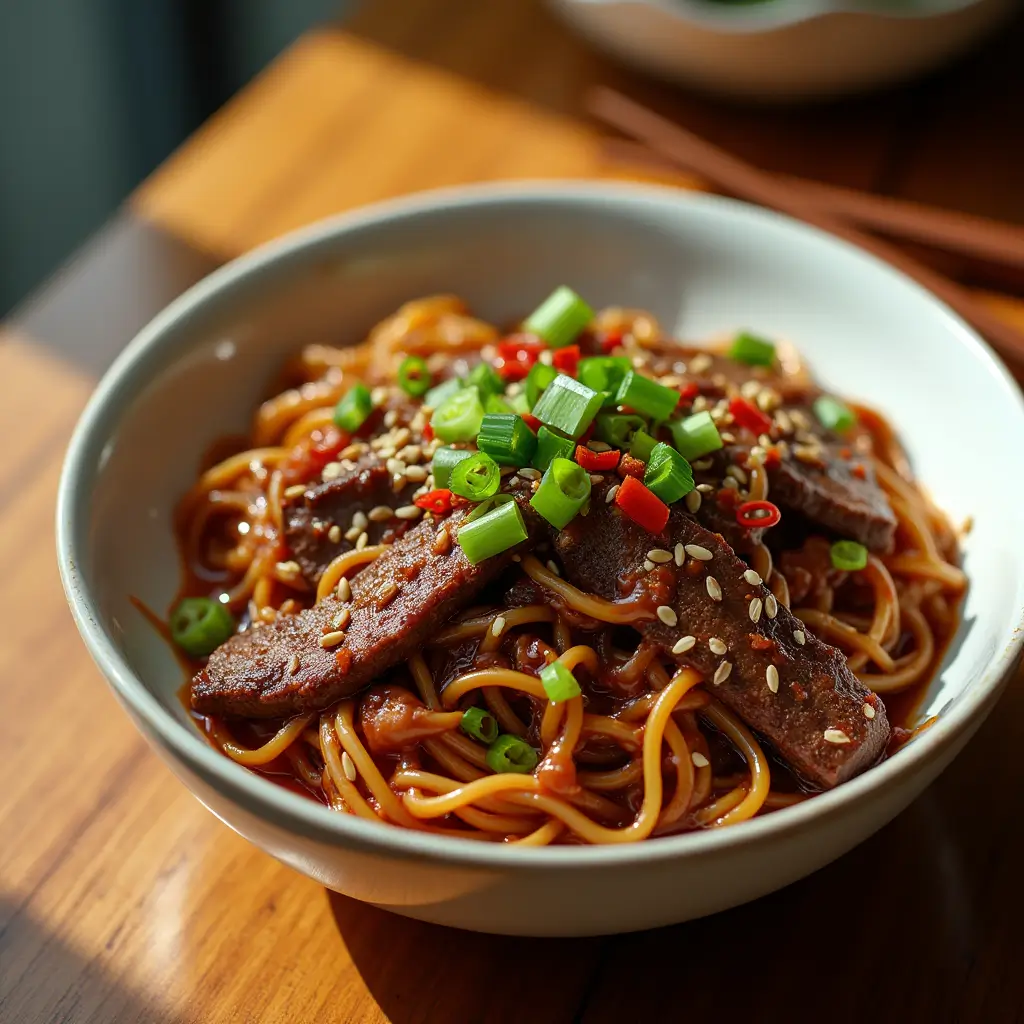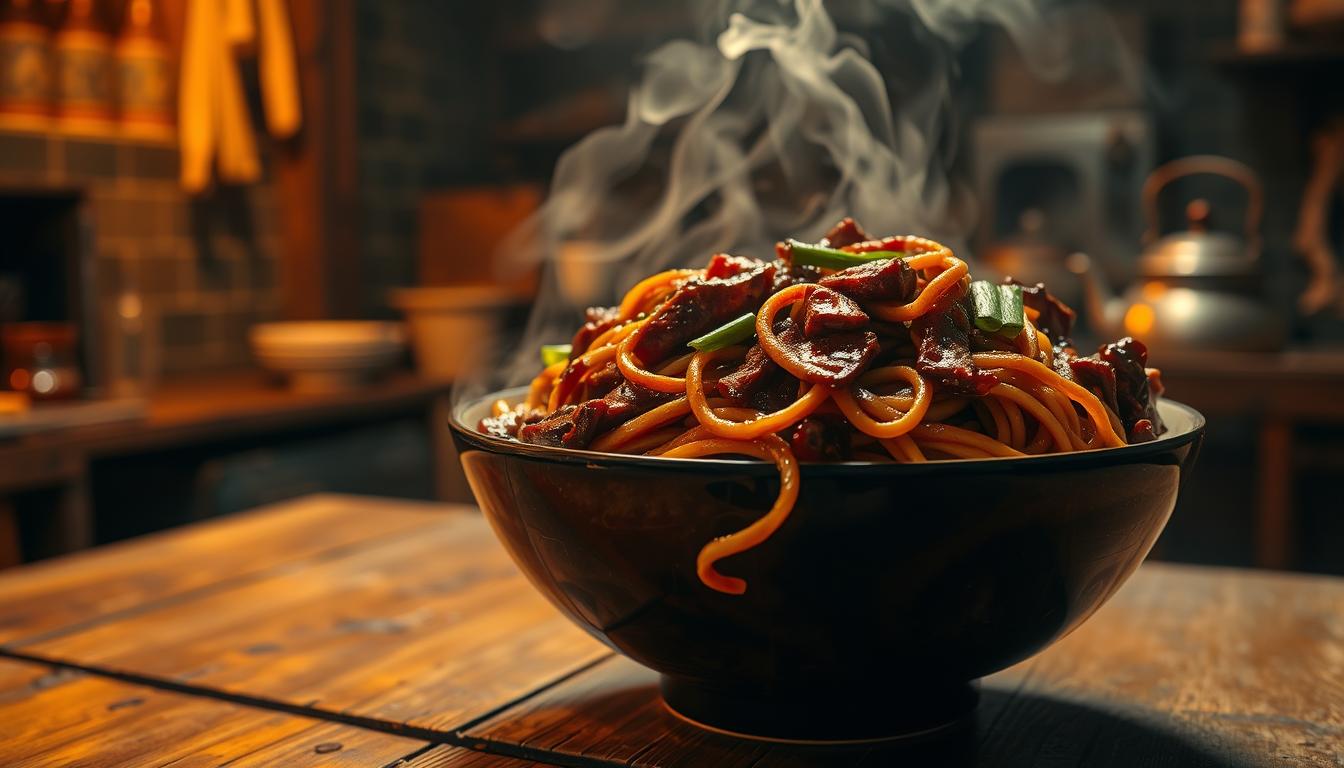Sticky Beef Noodles
Imagine a dinner that’s quick and full of flavor. Sticky beef noodles are ready in under 30 minutes. They have soy-glazed beef, tender noodles, and crisp veggies, all in one pan.
This dish is perfect for anyone who loves Asian flavors or needs a fast meal. It’s easy to make and doesn’t leave you with a mess. The flavors are rich and satisfying, making you want more.
Table of Contents
Key Takeaways
- Ready in 30 minutes with minimal cleanup thanks to the one-pan method.
- Uses everyday ingredients like soy sauce, garlic, and beef for a bold, savory-sweet taste.
- Perfect for busy nights without sacrificing comfort or flavor.
- Vegetables like bell peppers or bok choy add crispness and color.
- Adjustable to dietary preferences—swap noodles or spice levels to suit your table.
Introduction to Sticky Beef Noodles
Sticky Beef Noodles are a tasty dish with tender beef in a thick, glossy sauce. This sauce sticks to soft noodles, making each bite satisfying. You can make it easily with crockpot asian beef recipes, combining tradition and convenience.

What Are Sticky Beef Noodles?
The dish has thinly sliced beef marinated in hoisin sauce, garlic, and rice vinegar. The sauce gets thick during cooking, making a sticky coating for noodles. Blogs like Saveur love its mix of salty, sweet, and umami flavors. You can also adjust the spice to your liking.
The Origin and Inspiration Behind the Dish
It comes from Asian street food, where slow-cooked meats meet noodles for a filling meal. Its exact origins are unclear, but it shows the mix of Chinese and Vietnamese cooking styles. Now, crockpot asian beef recipes make it easy to enjoy at home, saving time in the kitchen.
Essential Ingredients and Tools for Your Recipe
Starting your sticky beef noodles journey requires the right ingredients and tools. Whether you’re making a classic dish or trying a twist like sticky beef and broccoli, the right supplies are key. Let’s look at what you need to make that savory sauce and tender beef.
Key Ingredients You Need
Begin with flank steak or sirloin cut thinly against the grain. Use Kikkoman soy sauce and Lee Kum Kee oyster sauce for flavor. Add hoisin sauce to thicken the sauce. Include fresh broccoli florets for the sticky beef and broccoli version.
Soak rice noodles in warm water for 10 minutes before cooking. Don’t forget minced garlic and grated ginger for that aroma.


Recommended Kitchen Tools
Choose a 12-inch carbon steel wok or heavy skillet for stir-frying. Stainless steel tongs help move broccoli and beef without bruising. Use a slotted spoon to drain excess oil from noodles.
Measuring spoons are crucial for precise sauce amounts.
| Tool | Purpose | Why It Matters |
|---|---|---|
| Wok | Stir-frying | Even heat distribution prevents burning |
| Tongs | Turning ingredients | Preserves broccoli texture |
| Slotted spoon | Draining noodles | Keeps sauce from diluting |
Quality tools like a Microplane grater for ginger and a measuring cup for broth ensure consistency. Adjust quantities to your liking. Now you’re set to start the step-by-step process.
Step-by-Step Preparation Process
Turn your ingredients into a delicious dish by following each step carefully. Here’s how to make garlic sticky noodles like a pro at home:
Preparing the Beef and Marinade
Cut beef into thin strips against the grain to avoid chewiness. Mix it with soy sauce, minced garlic, and rice wine vinegar. Let it marinate for 30 minutes to soak up the flavors.
Heat a wok until it smokes. This ensures the beef sears well instead of steaming.
Cooking the Noodles to Perfection
- Soak noodles in warm water for 5 minutes to soften them.
- Boil them briefly in salted water until tender, then drain.
- Save ½ cup of the noodle water for the sauce.
Combining Flavors for a Delicious Outcome
Put the seared beef back in the wok. Add the noodles and toss with the marinade. Mix in oyster sauce and noodle water.
Cook for 2 more minutes until the sauce sticks to the noodles. Top with fresh scallions and a sprinkle of garlic before serving.
Tips for Perfecting Your Sticky Beef Noodles
Mastering beef stir fry with rice noodles needs focus on details. Start by tasting the sauce before serving. Adjust salt or soy sauce to get the flavors right. Remember, too much salt is a common error—keep tasting.
- Sauce control: If the sauce is too thick, add water a little at a time. To thicken thin sauces, mix cornstarch with water (1 part cornstarch to 3 parts water).
- Noodle prep: Soak rice noodles in warm water for 5-7 minutes. Don’t soak too long, or they’ll become gummy. Rinse them under cold water briefly after soaking.
- Heat mastery: Stir-fry beef on high heat. Sear the meat until it’s browned on the edges before adding sauce. Cooking on low heat can make the texture sticky.
- Substitution guide: You can use chicken or tofu instead of beef. Add snap peas or bok choy in the last 2 minutes for a crunch.
- Plating: Mix noodles with sauce just before serving to keep them from getting soggy. Add garnishes like chopped scallions, sesame seeds, or a lime wedge for extra flavor.
Try adding chili flakes or sriracha for more spice. Always cook noodles separately and mix them in at the end for the best texture. These tips will make your beef stir fry with rice noodles taste like it’s from a restaurant.
Exploring Crockpot and Alternative Asian Beef Recipes
Try new twists on sticky beef noodles for dinner. Crockpot recipes make prep easy. Adding broccoli or garlic can boost the flavor.
These ideas are perfect for busy days or different tastes. Mix and match to enjoy the dish in new ways.
Sticky Beef and Broccoli Variations
Throw in broccoli florets halfway through cooking for a nutritious twist. Use broccolini for a crunchier, milder version. For a zesty touch, toss cooked veggies in a lemon butter sauce.
Slow cooker lovers can mix beef, broccoli, and spices for a hassle-free meal.
Garlic Sticky Noodles and More
Boost garlic flavor by using more cloves in the marinade. Mix noodles with a sauce of butter, roasted garlic, and soy sauce for a rich taste. Add red pepper flakes or Korean gochugaru for a spicy kick.
For a quick meal, stir-fry beef, garlic, and noodles in a skillet. For crockpot meals, layer ingredients and cook on low for 4-6 hours.
Serving Suggestions and Creative Pairings
Make your meal special by adding thoughtful sides and a nice presentation. These simple touches turn the dish into a feast that’s both balanced and Instagram-worthy. They highlight the flavors of healthy noodle dishes.
Accompaniments for an Inviting Meal
Pair your healthy noodle dishes with fresh, light sides. These sides balance richness and nutrition:
- Fresh tossed salads with citrus vinaigrette
- Steamed seasonal vegetables like asparagus or bok choy
- Sprinkle toasted sesame seeds or crushed peanuts for texture
- Lime wedges for a bright, tangy garnish
Plating Ideas to Impress Your Guests
Arrange your dish to show off vibrant colors and textures. Mound noodles slightly in the center, then:
- Drizzle chili oil in concentric circles around the edges
- Garnish with microgreens or thinly sliced scallions
- Place a small side bowl of hoisin sauce for dipping
Use bold-colored plates to make the dish stand out. Deep plates contrast well with golden noodles and red chili accents. Make each element visually distinct yet cohesive to elevate healthy noodle dishes.
Troubleshooting Common Recipe Issues
Mastering chinese meals at home means fixing common problems. Here are tips to solve key issues:
- Soggy Noodles: Cook noodles until they’re firm but not hard (al dente). Drain them right away. Add a teaspoon of oil to prevent sticking. Don’t mix noodles with the sauce until you’re ready to serve to keep them firm.
- Overly Salty Sauce: Fix saltiness by adding unsalted broth or water little by little. Add a squeeze of lime or a spoonful of honey to brighten the flavors. Stir in diced potatoes while simmering to soak up excess salt—remove before serving.
- Uneven Beef Texture: Cut beef into thin, even strips against the grain. Marinate to make it tender. Cook in a hot, oiled skillet in batches. Remove the beef once it’s cooked to prevent it from getting tough, then add it back in at the end.
Adjust the seasoning slowly while cooking chinese meals at home. Taste often and add small amounts of ingredients. Using the right techniques keeps your dishes fresh and tasty every time.
Health Conscious Modifications and Delicious Cooking Recipes
Changing Sticky Beef Noodles to fit health goals doesn’t mean losing flavor. These tweaks make delicious cooking recipes that match dietary needs without losing taste.
Low-Sodium and Gluten-Free Alternatives
- Swap regular soy sauce with low-sodium Kikkoman or gluten-free Tamari.
- Use Schar’s rice noodles for gluten-free noodles that stay firm and flavorful.
- Replace sugar with monk fruit sweetener to cut calories while maintaining sweetness.
| Traditional | Modification | Brand Example |
|---|---|---|
| Regular soy sauce | Low-sodium soy sauce | Kikkoman |
| Wheat noodles | Gluten-free rice noodles | Schar |
| Table sugar | Monk fruit sweetener | Natural Sweeteners |
Balancing Healthy Ingredients with Flavor
Boost umami with roasted garlic or shiitake mushrooms instead of salt. Add steamed veggies like broccoli or bok choy for extra nutrients. Drizzle a small amount of sesame oil to enhance richness without excess fat.
These changes turn this dish into a delicious cooking recipes that meet modern dietary needs. It shows healthy eating can still be indulgent.
Conclusion
Sticky Beef Noodles show that a top-notch meal can be made in under 30 minutes. This sticky noodles recipe mixes marinated beef, colorful veggies, and a tangy sauce. It’s both easy to make and impressive.
By prepping ingredients early and cooking at high heat, you get crispy beef, tender veggies, and noodles smothered in flavor.
Make this dish your own by swapping steak for tofu, changing spice levels, or using gluten-free noodles. It’s a balanced meal with protein, veggies, and carbs. You can freeze leftovers or serve it with light sides like cucumber salad.
This recipe is perfect for a quick weeknight dinner or a casual get-together. Its bold flavors and quick cooking time beat takeout any day. Next time you want Asian flavors, try this sticky noodles recipe for a meal that’s both satisfying and simple.
FAQ
What can I serve with Sticky Beef Noodles?
Sticky Beef Noodles go great with fresh salads, steamed veggies, or egg rolls. For a healthier option, try stir-fried greens or a cucumber salad.
Can I make Sticky Beef Noodles in a crockpot?
Yes, you can! Use a crockpot for a slow-cooked version. Just add noodles later to avoid them getting too soggy.
How do I adjust the flavor if my sticky sauce is too salty?
If the sauce is too salty, add a bit of water or low-sodium broth. A touch of sugar or honey can also balance the flavors.
What types of noodles work best for this recipe?
Rice or egg noodles are perfect for Sticky Beef Noodles. They soak up the sauce well. You can also try whole wheat or gluten-free noodles for a healthier choice.
What are some healthy modifications I can make to this dish?
Use low-sodium soy sauce to cut down on salt. Choose gluten-free soy sauce if needed. Adding more veggies like broccoli or bell peppers boosts fiber and taste.
Can I use different types of meat in this recipe?
Yes! You can swap beef for chicken, pork, or tofu for a veggie option. Just adjust cooking times based on the meat.
How can I store leftover Sticky Beef Noodles?
Keep leftovers in an airtight container in the fridge for up to three days. Reheat with a bit of water or broth to keep it moist.
What types of sauces can I use to enhance the flavor?
Try adding oyster sauce, chili paste, or hoisin sauce. These can add new flavors to your dish.

